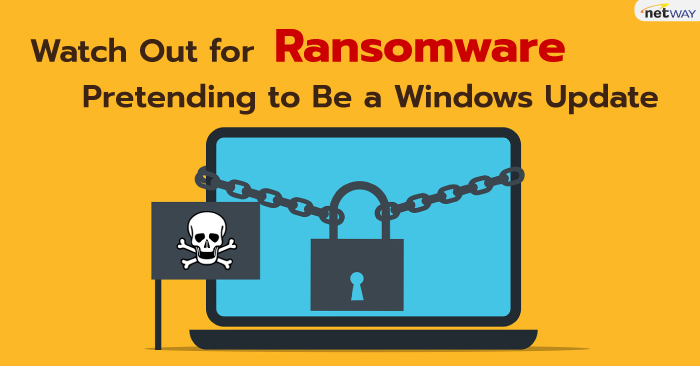-
Welcome to My Website
This is a text box. Write your own content here. This is an excellent place for you to add a paragraph.
Watch Out for Ransomware Pretending to Be a Windows Update

Watch Out for Ransomware Pretending to Be a Windows Update

Imagine you’re working away on your PC and see a Windows update prompt. Instead of
ignoring it, you take action. After all, you want to keep your device safe. But when you
install what you think is a legitimate update, you’re infected with ransomware.
That’s the nightmare caused by an emerging cybersecurity threat.
9
Cybercriminals are constantly devising new ways to infiltrate systems. They encrypt
valuable data, leaving victims with difficult choices. Once ransomware infects your system,
your PC is pretty useless. You either have to pay a ransom or get someone to remove the
malware. As well as install a backup (if you have one!).
One such variant that has emerged recently is the "Big Head" ransomware. It adds a new layer of deception by disguising itself as a Windows update. In this article, we'll explore the ins and outs of Big Head ransomware. Including its deceptive tactics. We well as how you can protect yourself from falling victim to such attacks.
The Big Head Ransomware Deception
Ransomware attacks have long been infamous for their ability to encrypt files. This renders
them inaccessible to the victim until a ransom is paid to the attacker. In the case of Big
Head ransomware, the attackers have taken their tactics to the next level. The attack
masquerades as a Windows update.
Big Head ransomware presents victims with a convincing and fake Windows update alert.
Attackers design this fake alert to trick users. They think that their computer is undergoing
a legitimate Windows update. The message may appear in a pop-up window or as a
notification.
The deception goes even further. The ransomware uses a forged Microsoft digital signature. This makes the fake update appear more authentic. This adds an extra layer of credibility to the malicious message. And makes it even more challenging for users to discern its true nature.
The attack fools the victim into thinking it’s a legitimate Windows update. They then
unknowingly download and execute the ransomware onto their system. From there, the
ransomware proceeds to encrypt the victim's files. Victims see a message demanding a
ransom payment in exchange for the decryption key.
By 2031, it’s expected a ransomware attack will occur every 2 seconds.
Protect Yourself from Big Head Ransomware & Similar Threats
Keep Software and Systems Updated
Verify the Authenticity of Update
Verify the Authenticity of Update
Backup Your Data
Use Robust Security Software
Educate Yourself and Others
Use Email Security Measures
Enable Firewall and Network Security
Disable Auto-Run Features
Be Wary of Pop-Up Alerts
Keep an Eye on Your System
Have a Response Plan
Need a Cybersecurity Audit?
Article used with permission from The Technology Press.
บทความในส่วนนี้
-
แนวทางการใช้ Microsoft 365 Copilot เพื่อเพิ่มประสิทธิภาพการทำงาน และการสร้าง Prompt ในสายงานต่างๆ
Updated on 2025-12-03 04:57:55
-
ของขวัญปีใหม่จาก Netway ซื้อหรืออัปเกรด Microsoft 365 Business Premium วันนี้ รับคูปองเติมน้ำมันฟรี
Updated on 2025-12-01 03:55:53
-
มีอะไรใหม่ใน Microsoft 365 Copilot ช่วงท้ายปี 2025
Updated on 2025-11-27 04:07:37
-
November 2025 - Netway Combo ข่าวสารรายเดือน พ.ย. 2568
Updated on 2025-11-06 09:20:17
-
ข่าวดี! Microsoft 365 Enterprise Plan สามารถซื้อพร้อม Microsoft Teams ได้อีกครั้งแล้ว
Updated on 2025-11-05 04:07:35

-
Domain
-
Hosting
-
Cloud & Managed
-
SSL
-
Email
- เรียนรู้เพิ่มเติม
- Microsoft 365 รุ่นต่างๆ
- Microsoft 365 สำหรับธุรกิจ
- Microsoft 365 สำหรับใช้งานที่บ้าน
- ทดลองฟรี
- G Suite
- เทคนิคลดต้นทุนอีเมล Microsoft 365 มากกว่า 28%
- เทคนิคลดต้นทุนอีเมล G Suite มากกว่า 19%
- Zimbra-Based Email
- Traditional Email by cPanel
- Physical to Cloud Migration
- Exchange Server to Microsoft 365 Migration
- G Suite to Microsoft 365 Migration
- Microsoft 365 to G Suite Migration
- Cloud to Cloud Migration
-
Microsoft
-
Google
-
Marketing
-
Others
-
Blog
-
Microsoft Teams
-
microsoft-365-business-premium
-
test-slide
-
Order
-
Promo